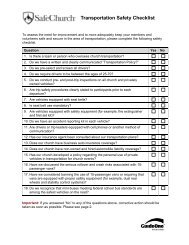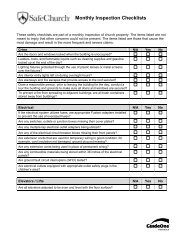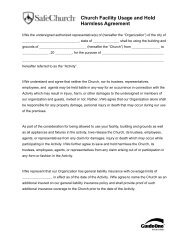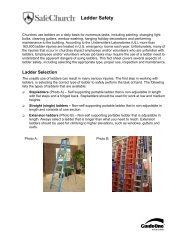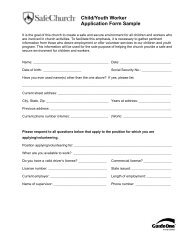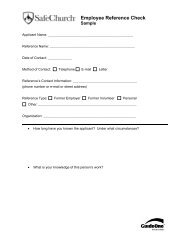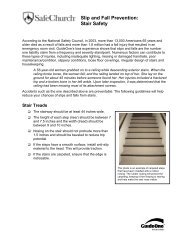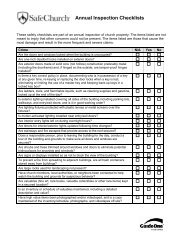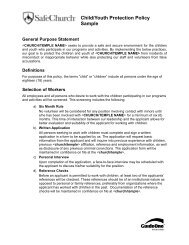You also want an ePaper? Increase the reach of your titles
YUMPU automatically turns print PDFs into web optimized ePapers that Google loves.
Background<br />
LOSS CONTROL TECHNICAL BULLETIN<br />
EXTERIOR INSULATION & FINISH SYSTEMS (<strong>EIFS</strong>)<br />
TB 3200<br />
Page 1 of 10<br />
Rev 052710<br />
Philadelphia Insurance Companies (PIC) primary exposures to Exterior Insulation & Finish Systems (<strong>EIFS</strong>) are related to<br />
construction defect liability claims (i.e. products liability or completed operations). Construction contractors often tender<br />
construction defect claims to their insurance company under the general liability policy in an attempt to obtain insurance<br />
coverage for their construction defect liabilities. Manufactures also tender products liability claims for similar reasons.<br />
Research on this topic indicates that the major causes of loss for <strong>EIFS</strong> are reportedly caused by two hazards: improper<br />
installation by the applicator contractors resulting in future building deterioration, and poor product design by the <strong>EIFS</strong><br />
manufacturers. Property coverage’s are primarily unaffected as deterioration is typically excluded in Homeowners and<br />
Commercial Property Policies; however, the crucial question is what causal event will be held legally accountable for the<br />
water-related deterioration loss.<br />
Standard<br />
Corporate Underwriting should be contacted prior to writing a manufacturer or applicator of <strong>EIFS</strong>. PIC' stance is that only<br />
<strong>EIFS</strong> Industry Members Association (EIMA) manufacturers and installers/applicators/contractors qualify for insurance<br />
coverage. Membership information can be obtained by accessing the Internet page:<br />
http://www.eifsfacts.com/eima/members.htm<br />
EIMA is a non-profit trade association comprised of 434 of the industry’s leading manufacturers, suppliers, distributors and<br />
applicators. This association consists of 12 manufacturing members (listed at the end of this document) and 146 applicator<br />
contractors.<br />
Insurance coverage is only contingent upon a loss control report that rates the insured as “Good” or better.<br />
Loss Control Responsibility<br />
Loss Control shall complete a survey and report providing a complete investigation of the residential/commercial builder,<br />
<strong>EIFS</strong> manufacturer, or exterior finish contractor-requesting coverage. This report shall provide the underwriter with a<br />
complete description of the manufacturer’s/contractor’s recall practices, log of complaints, past and present litigation<br />
information, product complaint handling procedures, a list of approved contractors/installers who use their product, and a<br />
description of legal contracts (hold-harmless and indemnity), etc.<br />
Loss control will provide an overall rating of the insured based on the review of the above information. If all pertinent<br />
information related to the <strong>EIFS</strong> is not obtained, the risk shall be classified as “Poor”.<br />
Loss Control shall not conduct any <strong>EIFS</strong> site surveys or inspections. If an <strong>EIFS</strong> Moisture Intrusion test is warranted or<br />
recommended, an inspector certified by the Council of American Building Official’s (CABO) must be used. CABO writes<br />
building codes for residential construction in the United States. These codes have been adopted into law by many states.<br />
<strong>EIFS</strong> Moisture Intrusion Testing Specialists use a combination of non-intrusive moisture detectors and intrusive moisture<br />
detectors to identify areas of the home that have moisture damage. The testing for homes generally runs anywhere from<br />
$600 to $1,600 depending on the size of the home. Larger structures will be considerably more depending upon the<br />
number of <strong>EIFS</strong> wall structures, entryways, windows, etc. Testing can identify the need for small maintenance and sealing<br />
improvements and/or the need for major <strong>EIFS</strong> and structural repairs.<br />
What is <strong>EIFS</strong><br />
Exterior Insulation and Finish Systems (<strong>EIFS</strong>), also known as synthetic stucco or Dryvit Board, are multi-layered exterior<br />
wall systems that are used on both commercial buildings and homes.<br />
Developed in Europe in the 1950s, <strong>EIFS</strong> were introduced in the U.S. almost 30 years ago. They were first used on<br />
IMPORTANT NOTICE - The information and suggestions presented by Philadelphia Indemnity Insurance Company in this Technical Bulletin are<br />
for your consideration in your loss prevention efforts. They are not intended to be complete or definitive in identifying all hazards associated<br />
with your business, preventing workplace accidents, or complying with any safety related, or other, laws or regulations. You are encouraged to<br />
alter them to fit the specific hazards of your business and to have your legal counsel review all of your plans and company policies.
LOSS CONTROL TECHNICAL BULLETIN<br />
TB 3200<br />
Page 2 of 10<br />
Rev 052710<br />
commercial buildings (shopping centers, condominium complexes, and office buildings). Use of the product in the<br />
residential industry began in the 1980’s as it was seen as an excellent insulator and it was easily molded into fancy<br />
architectural flourishes seen in mid to higher priced houses. In general, they provide superior energy efficiency and offer<br />
much greater design flexibility than other cladding products.<br />
Today, <strong>EIFS</strong> account for 17% of the U.S. commercial exterior wall market and about 3.5% of the residential wall market.<br />
Growth is strong in both sectors, especially in the residential area, where sales are increasing at the rate of 12 - 18% per<br />
year. It is estimated that several hundred thousand homes throughout the U.S. are now partially or totally clad with<br />
synthetic stucco. While the cost an <strong>EIFS</strong> is approximately three times the price of vinyl siding, it’s less expensive than stone<br />
or brick. The synthetic stucco’s components together cost builders about $5.50 to $6.50 a square foot. Traditional stucco<br />
costs about $3.50 per square foot, but has much less design flexibility.<br />
<strong>EIFS</strong> usage in commercial buildings zoomed from 115 million sq. ft. in 1989 to 175 million sq. ft. by 1995 (21 %<br />
of the total). The industry said 1997's total would be 300 million sq. ft. There also appears to be strong growth in<br />
the home market, which is about 30 percent of sales for some <strong>EIFS</strong> manufacturers.<br />
<strong>EIFS</strong> typically consist of the following components:<br />
• Insulation board, made of polystyrene or polyisocyanurate foam, which is secured to the exterior wall surface with a<br />
specially formulated adhesive and/or mechanical attachment.<br />
• A durable, water-resistant base coat, which is applied on top of the insulation and reinforced with fiberglass mesh for<br />
added strength.<br />
• A durable finish coat — typically using acrylic co-polymer technology — that is both colorfast and crack-resistant.<br />
IMPORTANT NOTICE - The information and suggestions presented by Philadelphia Indemnity Insurance Company in this Technical Bulletin are<br />
for your consideration in your loss prevention efforts. They are not intended to be complete or definitive in identifying all hazards associated<br />
with your business, preventing workplace accidents, or complying with any safety related, or other, laws or regulations. You are encouraged to<br />
alter them to fit the specific hazards of your business and to have your legal counsel review all of your plans and company policies.
<strong>EIFS</strong> Manufacturers<br />
LOSS CONTROL TECHNICAL BULLETIN<br />
TB 3200<br />
Page 3 of 10<br />
Rev 052710<br />
There are between 30 to 40 manufacturers of <strong>EIFS</strong> in the U.S. Eight (8) of these manufacturers are members of the <strong>EIFS</strong><br />
Members Association (EIMA). The list of manufacturers who are members are listed at the end of this Loss Control<br />
Technical Standard. Dryvit Systems is the nations largest manufacturer of the siding system.<br />
Installation/ Application<br />
<strong>EIFS</strong> are definitely not do-it-yourself wall claddings. They should be installed only by experienced applicators who have<br />
completed an <strong>EIFS</strong> manufacturer’s training program.<br />
The 8 approved manufacturers of the <strong>EIFS</strong> Members Association (EIMA) provide extensive specifications for all applicators<br />
using their products. EIMA also offers <strong>EIFS</strong> training manuals and training programs.<br />
The installation process begins with the preparation of the gypsum board/plywood attached to the metal/wood studs to the<br />
frame of the house. A 1inch thick sheet of polystyrene insulation is placed on top of this gypsum board/plywood by way of<br />
either gluing or using mechanical fasteners. A cement base is applied to the polystyrene with a fiberglass mesh then<br />
embedded in the cement. A final layer of acrylic finish is added in various thicknesses, which aids in either providing a<br />
coarse or smooth finish. The most critical part of the process is the assurance that the flashing is properly applied<br />
around windows and doorframes and that caulking is properly applied and maintained.<br />
To ensure long-term performance of <strong>EIFS</strong>, EIMA recommends that the following steps be taken on all <strong>EIFS</strong> jobs:<br />
• Selection of an EIMA member manufacturer who can provide technical support, documented product and system test<br />
results, as well as building code compliance information.<br />
• Selection of a knowledgeable, experienced applicator who has current approval of the manufacturer.<br />
• Verification from the manufacturer that the project plans and specs contain sufficient information and details to provide a<br />
weather-tight building envelope.<br />
• Verification that all components are supplied and/or approved by one manufacturer.<br />
• A review by the <strong>EIFS</strong> manufacturer of any unusual project details or conditions before work commences.<br />
• Verification that the proper materials (with identification and labels intact) were shipped and stored in accordance with<br />
the manufacturer’s requirements.<br />
• A complete review of the sequencing & scheduling with all subcontractors, prior to the start of the project.<br />
• A review of the scope of the work, project and site conditions, sequencing, and other matters, with the <strong>EIFS</strong> applicator,<br />
prior to the start of the project.<br />
• Examination of the substrate for proper tolerances, cleanliness, etc.<br />
• Periodic inspection of the application of <strong>EIFS</strong> components to ensure that the manufacturer’s recommended procedures<br />
are being followed.<br />
• Verification that critical related items are being properly installed, especially quality windows and doors, flashing and<br />
sealants.<br />
The Issue/Problem<br />
The issue is that the barrier <strong>EIFS</strong> does not account for the fact that moisture can and will penetrate the exterior wall surface.<br />
Once moisture penetrates a barrier <strong>EIFS</strong> wall, it remains trapped inside the wall cavity, where it eventually rots water<br />
sensitive wood sheathings and framing.<br />
A barrier <strong>EIFS</strong> wall does not allow water penetration, however, water does intrude the system through a variety of means,<br />
including:<br />
IMPORTANT NOTICE - The information and suggestions presented by Philadelphia Indemnity Insurance Company in this Technical Bulletin are<br />
for your consideration in your loss prevention efforts. They are not intended to be complete or definitive in identifying all hazards associated<br />
with your business, preventing workplace accidents, or complying with any safety related, or other, laws or regulations. You are encouraged to<br />
alter them to fit the specific hazards of your business and to have your legal counsel review all of your plans and company policies.
LOSS CONTROL TECHNICAL BULLETIN<br />
TB 3200<br />
Page 4 of 10<br />
Rev 052710<br />
1) Windows (via gaps in joined multiple windows through improper construction and maintenance of sealants<br />
around cladding/window intersections, and through penetrations in window joints which drain water behind<br />
the system at the sill).<br />
2) Wall/roof intersections (via inadequate flashing details).<br />
3) Wall penetrations (via improper construction and maintenance of sealants around electrical and plumbing services).<br />
The problem encountered to this point has been primarily associated with residential construction as opposed to<br />
commercial. Several reasons exist in drawing conclusion to these circumstances, including:<br />
1) Commercial sites may be better supervised ensuring that the detailing such as backer rods and sealants are properly<br />
installed and maintained.<br />
2) Window construction in commercial buildings generally feature fixed windows which are less prone to moisture<br />
infiltration.<br />
3) Roof construction on commercial building projects often do not feature complex roof slopes and valley and wall/roof<br />
intersections found on residential construction.<br />
The Results<br />
The problem has come to prominence within the past two years due to the large number of homeowner claims filed in North<br />
Carolina. Repairs from damage to <strong>EIFS</strong> homes range from $1,000 to $200,000. Typical repairs are from $18,000 to<br />
$50,000.<br />
Some states, including the Carolinas, are requiring sellers to disclose whether their house contains synthetic stucco, even if<br />
it’s performing properly.<br />
Bankers and insurance companies have taken a hard line as well. Some banks won’t give building loans for <strong>EIFS</strong> houses.<br />
In the fall of 1996, Maryland Casualty Company, the largest insurer of builders in the country, made an underwriting<br />
decision to stop writing liability insurance for <strong>EIFS</strong> contractors. Maryland Casualty was the first, but other insurance<br />
companies are also moving in that direction. Presently, State Farm, after reviewing all of the data, does not have an<br />
underwriting concern.<br />
Since the problem has arisen, at least 12 class action lawsuits, brought on behalf of homeowners nationwide whose houses<br />
were sided with <strong>EIFS</strong> manufactured by the defendants, have been filed against the <strong>EIFS</strong> manufacturers. The lawsuits<br />
allege that the claddings trap moisture in the wall cavities of homes, causing damage to the wood sheathing.<br />
IMPORTANT NOTICE - The information and suggestions presented by Philadelphia Indemnity Insurance Company in this Technical Bulletin are<br />
for your consideration in your loss prevention efforts. They are not intended to be complete or definitive in identifying all hazards associated<br />
with your business, preventing workplace accidents, or complying with any safety related, or other, laws or regulations. You are encouraged to<br />
alter them to fit the specific hazards of your business and to have your legal counsel review all of your plans and company policies.
LOSS CONTROL TECHNICAL BULLETIN<br />
TB 3200<br />
Page 5 of 10<br />
Rev 052710<br />
IMPORTANT NOTICE - The information and suggestions presented by Philadelphia Indemnity Insurance Company in this Technical Bulletin are<br />
for your consideration in your loss prevention efforts. They are not intended to be complete or definitive in identifying all hazards associated<br />
with your business, preventing workplace accidents, or complying with any safety related, or other, laws or regulations. You are encouraged to<br />
alter them to fit the specific hazards of your business and to have your legal counsel review all of your plans and company policies.
Case #1:<br />
LOSS CONTROL TECHNICAL BULLETIN<br />
The Verdict<br />
TB 3200<br />
Page 6 of 10<br />
Rev 052710<br />
RALEIGH, N.C. -- In a watershed victory for the Exterior Insulation and Finish Systems (<strong>EIFS</strong>) industry, the U.S. District<br />
Court for the Eastern District of North Carolina has denied a motion to certify a class action suit directed at 11 <strong>EIFS</strong><br />
manufacturers, including members of the <strong>EIFS</strong> Industry Members Association (EIMA).<br />
As a result of the ruling, only a handful of individually named plaintiffs can proceed with their suit against the manufacturers.<br />
Other homeowners who contend their <strong>EIFS</strong> siding is defective will not be covered by the suit.<br />
For their part, the manufacturers maintain that the moisture problems are caused by building professionals who fail to follow<br />
sound construction practices, such as sealing and flashing around windows, doors, deck terminations and other potential<br />
moisture entry points.<br />
The court found that the proposed nationwide class of owners of <strong>EIFS</strong> homes did not meet the requirements for class<br />
certification under federal law. The court determined that allocating responsibility for the moisture damage would be<br />
impossible without also examining the role of homebuilders, window manufacturers and other parties.<br />
In reaching its decision, the court held that the responsibility for moisture damage to <strong>EIFS</strong>-clad homes must be reviewed on<br />
a case-by-case basis. It noted that assessing damage to an individual home would require a unique analysis of the type of<br />
repairs needed, the cost of materials and labor required, the extent of the moisture problem and the building code under<br />
which the home was built.<br />
Stephan E. Klamke, Executive Director of EIMA, said the ruling represents a major victory for <strong>EIFS</strong> manufacturers and<br />
affirms the industry’s position that one product cannot be viewed in isolation when determining the source of moisture<br />
intrusion. “To focus only on <strong>EIFS</strong> without reviewing the entire wall system is to assume that each product in the wall<br />
operates independently,” Klamke said. “In fact, there is a symbiotic relationship between products such as sheathing, <strong>EIFS</strong>,<br />
windows, flashing and sealants, all of which must be properly installed for the wall system to function well. The court ruling<br />
further erodes the credibility of those who have sought to undermine <strong>EIFS</strong> by misrepresenting the facts,” Klamke added.<br />
Case #2:<br />
A jury in Tacoma, Washington. In June 1997, sided with Sto Corporation in a civil case that pitted the Atlanta-based<br />
manufacturer against two Tacoma area residents whose home allegedly was damaged by moisture intrusion. Several<br />
expert witnesses for the homeowners presented arguments similar to those directed at <strong>EIFS</strong> manufacturers in pending class<br />
action suits, but the arguments failed to sway the jury.<br />
In their suit, the homeowners claimed that Sto’s system was defective and prone to trap water, resulting in rotting of the<br />
home's wood framing. In vindicating Sto, the jury noted that the manufacturer provided a product that was reasonably safe<br />
as designed, issued adequate instructions for use of the product, and did not violate the Washington Consumer Protection<br />
Act.<br />
IMPORTANT NOTICE - The information and suggestions presented by Philadelphia Indemnity Insurance Company in this Technical Bulletin are<br />
for your consideration in your loss prevention efforts. They are not intended to be complete or definitive in identifying all hazards associated<br />
with your business, preventing workplace accidents, or complying with any safety related, or other, laws or regulations. You are encouraged to<br />
alter them to fit the specific hazards of your business and to have your legal counsel review all of your plans and company policies.
The Solution<br />
LOSS CONTROL TECHNICAL BULLETIN<br />
TB 3200<br />
Page 7 of 10<br />
Rev 052710<br />
In cases where homes have been damaged, the problems have been traced to the use of poor quality (even leaky and/or<br />
non code-compliant) windows and/or improper flashing and sealing. As a result, when building with <strong>EIFS</strong>, it is wise to use<br />
quality windows which are code-compliant, and to make sure there is proper flashing and sealing around windows, doors,<br />
roofs, deck-to-house attachments, and all other exterior wall penetrations.<br />
Periodic maintenance should include thorough checking of the flashing and sealing to ensure that the building envelope<br />
remains watertight. Damaged or missing flashing should be repaired or replaced immediately. Cracked or deteriorated<br />
sealants should be immediately repaired, or removed and replaced as well.<br />
The best way to assure a high quality <strong>EIFS</strong> job is to rely on members of the EIMA. <strong>EIFS</strong> manufactured by EIMA members<br />
meet all appropriate building code testing requirements and industry performance standards. Furthermore, each<br />
manufacturer conducts their own R&D to ensure optimal component compatibility; for that reason, it is important to specify<br />
that the entire system be furnished by a single-source EIMA member manufacturer.<br />
For additional information (including information on how to join EIMA), call the <strong>EIFS</strong> Industry Members Association at 1-800-<br />
294-3462 or 1-770-968-7945 or contact the organization by fax at 1-770-968-5818. If you prefer to write, the address is<br />
EIMA, 3000 Corporate Center Drive, Suite 270, Morrow, GA 30260.<br />
<strong>EIFS</strong> Member Manufacturers<br />
ACROCRETE, INC.<br />
1259 NW 21st Street<br />
Pompano Beach, FL 33069<br />
(954) 917-7665<br />
(800) 432-5097<br />
FAX (954) 917-2775<br />
DRYVIT SYSTEMS, INC.<br />
One Energy Way<br />
West Warwick, RI 02893<br />
(401) 822-4100<br />
(800) 556-7752<br />
FAX (401) 822-4510<br />
www.dryvit.com<br />
OMEGA PRODUCTS INTERNATIONAL, INC.<br />
P.O. Box 1869<br />
Orange, CA 92856<br />
(714) 935-0900<br />
(800) 600-6634<br />
FAX (714) 935-0800<br />
www.omega-products.com<br />
PAREX, INC.<br />
P.O. Box 189<br />
Redan, GA 30074<br />
(770) 482-7872<br />
(800) 537-2739<br />
FAX: (770) 482-6878<br />
www.parex.com<br />
IMPORTANT NOTICE - The information and suggestions presented by Philadelphia Indemnity Insurance Company in this Technical Bulletin are<br />
for your consideration in your loss prevention efforts. They are not intended to be complete or definitive in identifying all hazards associated<br />
with your business, preventing workplace accidents, or complying with any safety related, or other, laws or regulations. You are encouraged to<br />
alter them to fit the specific hazards of your business and to have your legal counsel review all of your plans and company policies.
PLEKO SYSTEMS INT'L, INC.<br />
P.O. Box 98360<br />
Tacoma, WA 98498-0369<br />
(866) 753-5648<br />
(253) 473-5138<br />
www.pleko.com<br />
STO CORP<br />
3800 Camp Creek Pkwy.<br />
Bldg. 1400, STE 120<br />
St. Atlanta, GA 30331<br />
(404) 346-3666<br />
(800) 221-2397<br />
FAX (404) 344-3214<br />
www.stocorp.com<br />
TEC SPECIALTY PRODUCTS, INC.<br />
315 South Hicks Road<br />
Palatine, IL 60067<br />
(847) 358-9500<br />
(800) 323-7407<br />
FAX (847) 776-4320<br />
T<strong>EIFS</strong> WALL SYSTEMS<br />
220 Burleson Street<br />
San Antonio, TX 78202<br />
(210) 472-2935<br />
(800) 358-4785<br />
FAX: (210) 472-2946<br />
www.teifs.com<br />
LOSS CONTROL TECHNICAL BULLETIN<br />
TB 3200<br />
Page 8 of 10<br />
Rev 052710<br />
IMPORTANT NOTICE - The information and suggestions presented by Philadelphia Indemnity Insurance Company in this Technical Bulletin are<br />
for your consideration in your loss prevention efforts. They are not intended to be complete or definitive in identifying all hazards associated<br />
with your business, preventing workplace accidents, or complying with any safety related, or other, laws or regulations. You are encouraged to<br />
alter them to fit the specific hazards of your business and to have your legal counsel review all of your plans and company policies.



